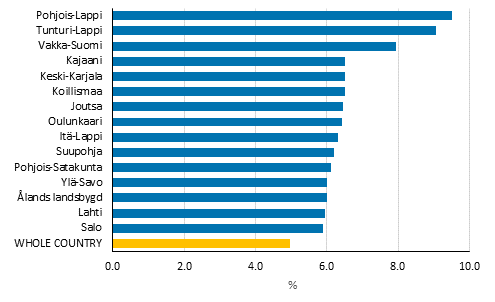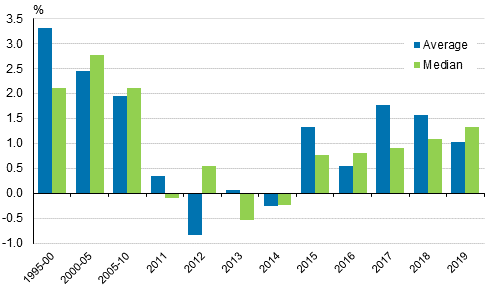Published: 17 December 2020
Income development of household-dwelling units fastest in Lapland in the past few years
In the sub-regional units of Pohjois-Lappi and Tunturi-Lappi, household-dwelling units' median income was in real terms good nine per cent higher in 2019 than in 2014, when the weak growth period of income that had continued for several years ended. In the sub-regional unit of Vakka-Suomi, household-dwelling units' income grew by eight per cent over the same period. The regional data of Statistics Finland's income distribution statistics show that according to median income that best describes the income of average household-dwelling units, income grew by five per cent in real terms in the whole country in 2014 to 2019.
Changes (%) in real income of household-dwelling units in 2014 to 2019, 15 sub-regional units with biggest growth

Income concept equivalent disposable monetary income (incl. sales profits) per household-dwelling unit, median. Equivalent income = the household-dwelling unit's income divided by its consumption unit figure. Source: Income distrubution statistics' total data
Of large sub-regional units, household-dwelling units' equivalent median income grew in real terms by 5.4 per cent in the sub-regional unit of Turku and by 5.1 per cent in the sub-regional unit of Helsinki in 2014 to 2019. The growth in the income of household-dwelling units was 4.9 per cent in the sub-regional units of Tampere and Oulu.
In recent years, income development has been weakest in the sub-regional units of Lappeenranta, Imatra, Vaasa and Kokkola, where real growth in household-dwelling units' median income was under three per cent in 2014 to 2019.
Growth in median income accelerated slightly in 2019
In the early 2010s, the income development of household-dwelling units was long modest, in some years household-dwelling units’ real income even decreased. In the middle of the decade, income development turned positive, after which income growth has continued moderate already for five years.
In particular, according to the median that best describes the income of average household-dwelling units, the income development of household-dwelling units has been good in recent years when compared to the early years of the decade. In contrast, there is still a long way to go to the growth figures of the late 1990s and early 2000s.
Measured by average, household-dwelling units' real income grew by one per cent in 2019 from the previous year, but according to median income, annual growth in household-dwelling units' real income was 1.3 per cent last year. This is a couple of tenths more than one year before.
Household-dwelling units' disposable monetary income consists of wages and salaries, and entrepreneurial and property income received by the members of the household-dwelling units during the year, as well as received social security benefits and pensions (including earnings-related pensions), from which compulsory taxes and tax-like payments paid on the income have been deducted. All tax-free income (such as child benefits, housing and subsistence allowances, and tax-free dividends) are also taken into account in income.
Annual changes in household dwelling-units’ real income in 1995 to 2019

Change in 1995 to 2000, 2000 to 2005 and 2005 to 2010 describes the average annual change in the period. Income concept: equivalent disposable monetary income (excl. sales profits) per household-dwelling unit. Equivalent income = the household-dwelling unit's income divided by its consumption unit figure. Source: Income distrubution statistics' total data
Source: Income distribution statistics 2019, Statistics Finland
Inquiries: Pekka Ruotsalainen 029 551 2610
Head of Department in charge: Hannele Orjala
- Tables
-
Tables in databases
Pick the data you need into tables, view the data as graphs, or download the data for your use.
Updated 17.12.20
Official Statistics of Finland (OSF):
Income distribution statistics [e-publication].
ISSN=1799-1331. Poverty 2019. Helsinki: Statistics Finland [referred: 29.12.2025].
Access method: http://stat.fi/til/tjt/2019/02/tjt_2019_02_2020-12-17_tie_002_en.html

